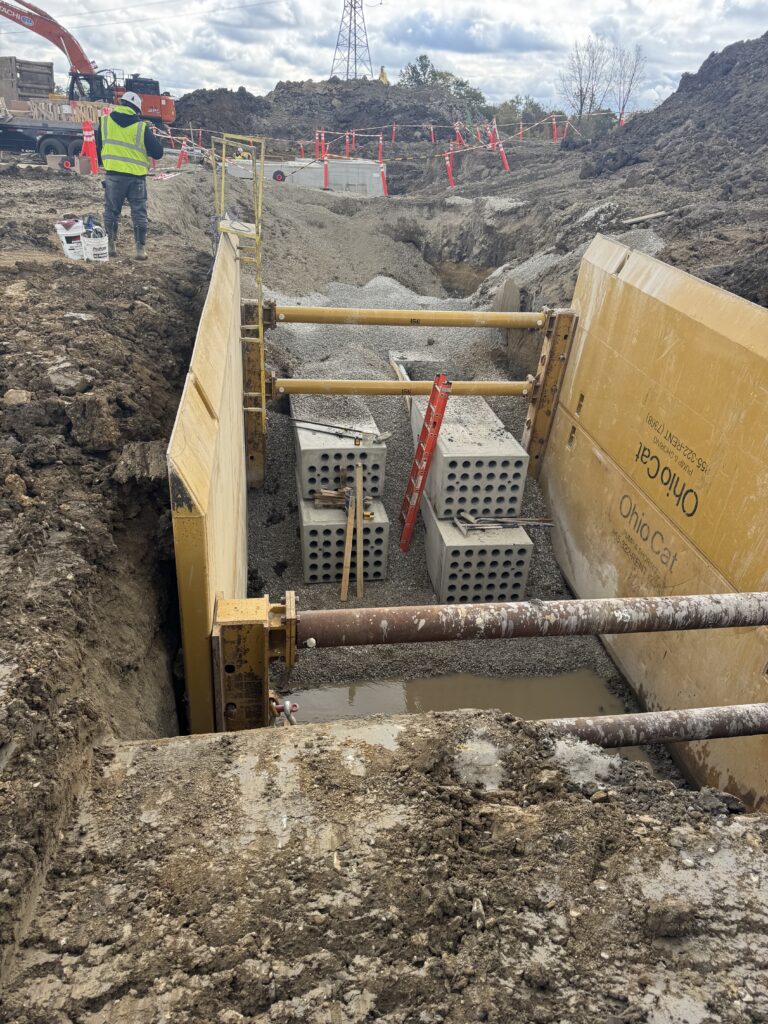Load ratings aren’t marketing language — they’re engineering commitments. When a duct bank sits under a roadway, a crane path, or a taxiway, it’s not the drawing that gets tested — it’s the concrete under real wheels. We’ve seen too many systems fail because someone treated “traffic rated” as a line item instead of a design condition. That’s why at DBO, we test every rating like it’s a worst-case scenario, not a checkbox.
What Those Ratings Actually Mean
Every environment carries its own load signature.
- Traffic Rated (HL-93): The AASHTO highway benchmark. It represents the combined weight of a fully loaded semi-truck — roughly 72,000 pounds of live load — plus a distributed lane load. It’s the design case for almost every yard, crane path, and street crossing.
- Rail Rated: Designed for the point loads and dynamic impact of rolling steel. The vertical pressures are sharp and repetitive, focused through wheel contact patches just a few inches wide.
- Aircraft Rated: Where wheel loads exceed 100,000 pounds and spacing between gear sets creates complex stress paths. These applications demand higher compressive strength, more steel, and reduced deflection.
At DBO, we don’t pull a catalog part for these conditions — we model them, reinforce them, and prove them before anything leaves the yard.
HL-93 Is Our Baseline, Not Our Ceiling
Most specs stop at “HL-93 compliant.” We start there. Our duct banks are designed and tested to carry more than 25% above HL-93 — because we know what actually rolls over these installations: rough-terrain cranes, fuel trucks, lowboys, forklifts with solid tires, and the occasional 200-ton crawler track. We don’t build to the drawing’s ideal conditions. We build to the reality that happens after the job turns over.
The Unsupported Joint Test
We wanted proof, not theory. So we set two DBO duct bank sections end-to-end with a 12-inch unsupported gap — no soil, no bedding, no backfill. Then we loaded 60,000-pounds directly over the joint. No cracking. No conduit movement. No measurable deflection. That single test told us what our FEA models already predicted: our joint geometry and reinforcement don’t rely on soil to carry load. The structure carries itself. That’s the kind of test you only run when you’re confident in your design — and the kind of data you only get when you own every step of production.
How We Design for Heavy Loads
Every DBO duct bank starts as an engineered system:
- Concrete mix: minimum 5,000 psi, verified for low thermal resistivity and controlled cure.
- Reinforcement: steel cages and shear keys designed to carry full flexural and point loads.
- Joint geometry: precision-fit pins and shear interlocks to transfer load through the section, not across the conduit.
- Verification: full-scale testing matched to FEA models within 2% deflection tolerance.
Our engineers deliver stamped structural calculations within two weeks of design confirmation — because most projects don’t have a month to wait on submittals.
Built to Spec, Not to Inventory
One of the biggest misconceptions about precast is that you have to pick from what’s in stock. That’s not how we work.
DBO designs around your project:
- Cover depth, soil type, and surface load determine the reinforcement schedule.
- Joint geometry and alignment are adjusted to match your conduit configuration.
- We’ll build the form you need, not force your layout into ours.
If it’s going under a runway, we’ll build for it. If it’s going under a rail spur, we’ll build for that too. Every design is verified before it ever leaves our facility — structurally, thermally, and dimensionally.
Why Verification Matters
When a 100,000-lb aircraft or crane crosses above your buried infrastructure, there’s no second chance. A cracked duct bank doesn’t just mean rework; it means service interruption, safety risk, and liability. That’s why DBO designs and tests to failure — so you don’t have to see it in the field. Our process gives engineers data they can stamp with confidence and GCs peace of mind when they sign off on compaction. We’re not just compliant; we’re proven.
The Standard We Live By
Traffic. Rail. Aircraft. It doesn’t matter what crosses above — our approach stays the same:
Engineer it. Test it. Prove it. Deliver it ready.
Because when the spec says traffic rated, we read that as nothing fails here. That’s the DBO standard.



